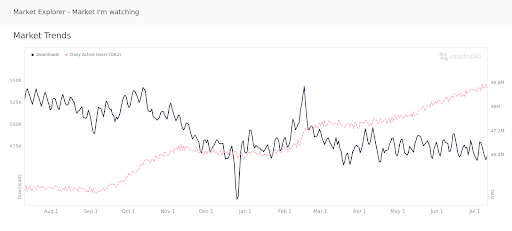The mobile industry is a great one to be in. A person’s smartphone is their most used and most personal device. So, if you’re able to create a product that belongs there, you have the potential to unlock a lucrative revenue stream.
In 2020, the Apple App Store and Google Play Store generated approximately $135 billion in revenue together. TikTok, the highest grossing app of 2020, generated $540 million alone. But for as many chart-topping apps there are, there are also plenty that should have been left in drafts.
If you have an idea for an app, you may be eager to go to production and get it in front of users as soon as you can. While that strategy works for some, it’s unlikely to yield the results you were hoping for. Whether you’re a product owner at a large brand or an indie app developer, you’ll want to take a step back from your idea and flesh out the details first. In this blog, we’ll help you answer:
- Is my app idea a good one?
- What is a proof of concept, and why does my mobile app need one?
- How do I make a proof of concept for my mobile app?
How do I know if I have a good app idea?
A good app idea is one that offers a specific solution to a specific problem. In the context of games, this would mean offering a specific type of gameplay to a hungry audience. Examples of apps that solve for specific problems are:
- Venmo: offers cashless payments between friends
- Vivino: helps you buy the right wine
- AllTrails: provides guides and maps for hiking
A great app idea is one that offers a specific solution, and has been validated with a proof of concept. Without a proof of concept, your idea will remain just that— an idea. Or, worse, you’ll waste critical time, money, and resources into producing an app that could have gone to a more lucrative one instead.
What is a proof of concept for a mobile app, and why do I need one?
A proof of concept, or POC, is a way of evaluating your mobile app idea and testing to see if it will work. Unless you’re a government agency or a nonprofit, a “working” app generally equates to a revenue-generating app. However, a successful app can also be one that builds brand recognition or loyalty, improves the overall customer experience, or sparks social change.
A proof of concept, which comes after the “I have an app idea” stage and before the prototype stage, helps you determine the viability of your app, as well as its potential design, features, and go-to market strategy. It will not only help you answer questions like, “is my app going to make money?” but also “how will my app make money?” These details matter, especially if you need to present your idea to a manager, board, or group of investors for approval.
It’s far easier to rework an idea on paper than it is to rework one already in production. Your app may sound good in theory, but after some research, you may discover that there are too many potential risks to continue. For example, after conducting a marketing analysis using similar apps, you may discover that the market’s revenue is declining, or it’s too crowded to join. A POC helps you prepare for all possibilities and create the best possible app.
How do I create a proof of concept for my mobile app?
Creating a proof of concept for your mobile app involves a good amount of research, which can be completed in stages. While a POC for a hyper-casual zombie game will look very different from one for a weather app, they will all follow a similar flow. We’ve outlined the key steps of creating a POC for your mobile app below.
1. Identify the problem you are trying to solve or the niche you are trying to fill. In order to define your app, you need to understand the problem you’re solving and for whom (AKA your target audience). Read relevant articles, app user reviews, and community threads. What common themes or complaints are you noticing? Who is sharing these thoughts?
If there’s not a lot of information out there about your concept, you can consider creating a survey, focus group or starting your own discussion thread. While several other problems/ideas may surface during this stage of research, the key here is to focus on one. Otherwise, you’ll catch yourself trying to create a product for everyone. Specificity will serve you far better in the long run.
2. Identify similar apps to the one you are trying to create. Browse through apps in the iOS App Store or Google Play Store, or on an app intelligence platform. In the app stores, you can look through the top charts and featured lists. Query the app store using relevant keywords or phrases to see what appears in the search results.
If using an app intelligence platform, you can search by title, keywords, genre classification, and even feature tags to discover similar apps. Then, you can add these apps to a labeled market for easy analysis. Whichever method/platform you use, you’ll want to store the relevant apps in one place, so you can begin to collect information on them during the next step.

3. Conduct a market analysis and determine if there’s white space in the market. The list of apps you created in step #2 will serve as your market. While there are several ways to identify an opportunity within a market, one common way is to evaluate the market’s top-heaviness. Under this method, you need to find or estimate the total number of downloads for the market; then, calculate the percentage of downloads that were for the top/largest apps.
If the top 10-20 apps are responsible for 50% or more of the market’s total downloads, then it’s a top-heavy market. A top-heavy market is difficult to penetrate, especially if you’re a smaller publisher. In this scenario, you may want to identify a different app category or genre where there’s a larger opportunity for a greater number of apps.
If you only have access to publicly available data, you need to manually pull this data and upload it to your preferred data sandbox. Since the Google Play Store only provides a range for downloads, you will have to use approximates in your analysis. If you have access to a mobile intelligence platform, you can analyze the performance of the market based on accurate estimates for downloads, total revenue, DAU, MAU, sessions and more.
The more metrics you can include in your analysis, the more likely you will get an accurate picture of the market. For example, if a market’s downloads are declining, but revenue and MAU are holding, this means the market attracts highly engaged users that are willing to spend. If you only looked at downloads, you would have missed that conclusion and opportunity.

4. Refine your market/research to identify the best strategies. From your market analysis, you may have already started to pick out the top performing apps by measure of downloads, engagement, revenue and/or user sentiment. It’s time to hone in on those top performing apps.
- What features do they have that the poorer performing apps do not have?
- What were their most recent app updates and did the updates impact their performance?
- What do their user interfaces look like?
- What is their revenue model?
- What do users like most about the apps as judged by user reviews?
If you notice a pattern, like a shared feature or theme, among some of the top performing apps, feel free to add these to a submarket. You can analyze them apart from the other apps, and decide if you’d like to follow in their footsteps, or choose a different strategy altogether. This process is critical to a good POC. Without it, you’ll have to guess what app features are best to include.

Determine your app’s components and next steps. To conclude your POC, you’ll need to review your findings from the previous steps. Then, use those findings to identify and justify the key components of your app:
- Core purpose
- Target audience (e.g. age, gender, location, occupation, language, interests, habits)
- Features (e.g. search options, user feedback, social integration, push notifications)
- Design (e.g. colors, font, graphics)
- Revenue model (e.g. in-app advertising, in-app purchases, data monetization, donations, sponsorships, paid apps)
- Marketing strategy (e.g. paid campaigns, organic and ASO, email marketing, social media and influencer marketing)
If the data you collected supports your choices, you can likely begin creating a prototype or beta version of your app. If your findings are inconclusive or not confidence-inspiring, then you may want to return to the earlier steps in the POC process.
What tools can I use to create a proof of concept for my mobile app?
Product management tools help product teams carry out some or all phases of the product lifecycle, from planning, researching, developing, launching, assessing, and iterating on a product. If you’re working with a big team, these tools will be very helpful in dividing up work and ensuring that your POC is moving along. Some popular product management tools include:
If you have a smaller team or prefer not to add another tool to your stack, you can keep it simple by using Excel or Google Drive. All that matters is that you stay organized.
Social media applications and community discussion tools help you connect with your potential audience, understand their needs, and even interact with them directly. Join groups relevant to your app idea, respond to threads, or post original questions. App developers are known to hang out on the following apps:
Data management platforms and visualization tools help you collect, store, analyze and visualize data. If you are hoping to enter a saturated market with a lot of apps, these tools will be especially helpful as you conduct market analyses. Some popular options include:
- Amazon Web Services
- Tableau
- Flourish
- Excel (a spreadsheet, not a platform, but it does wonders!)
App stores and investor relation pages help you collect publicly available app performance metrics. On an app’s profile in the iOS App Store and Google Play Store, you can see its rank, approximate number of installs, reviews, and the date it was last updated. If you’re interested in including public companies in your research, you can also visit their investor relations pages. You can navigate to these simply by searching “[company name] investor relations.”
Mobile intelligence platforms, like Apptopia, are an all-in-one solution that provide performance estimates and metadata on every app in the app store. In these platforms, you can research and analyze your market, benchmark your performance, track your competitors and more. If you opt to use an intelligence platform, you can reduce the need for data management, visualization and research tools, as all of these features are included within the web tool. See how the popular games publisher PikPok uses Apptopia to uncover new app opportunities.
Recap: why your mobile app needs a proof of concept
A proof of concept will empower you to make smarter, data-driven decisions throughout the app development process. This will help you steer away from risky ideas, and toward those with higher ROI. Your team, and potential investors, will appreciate the forethought, guaranteeing a smoother development process overall. Just remember to be specific, find your niche and do your due diligence.
Get a free market analysis on five apps of
your choosing





